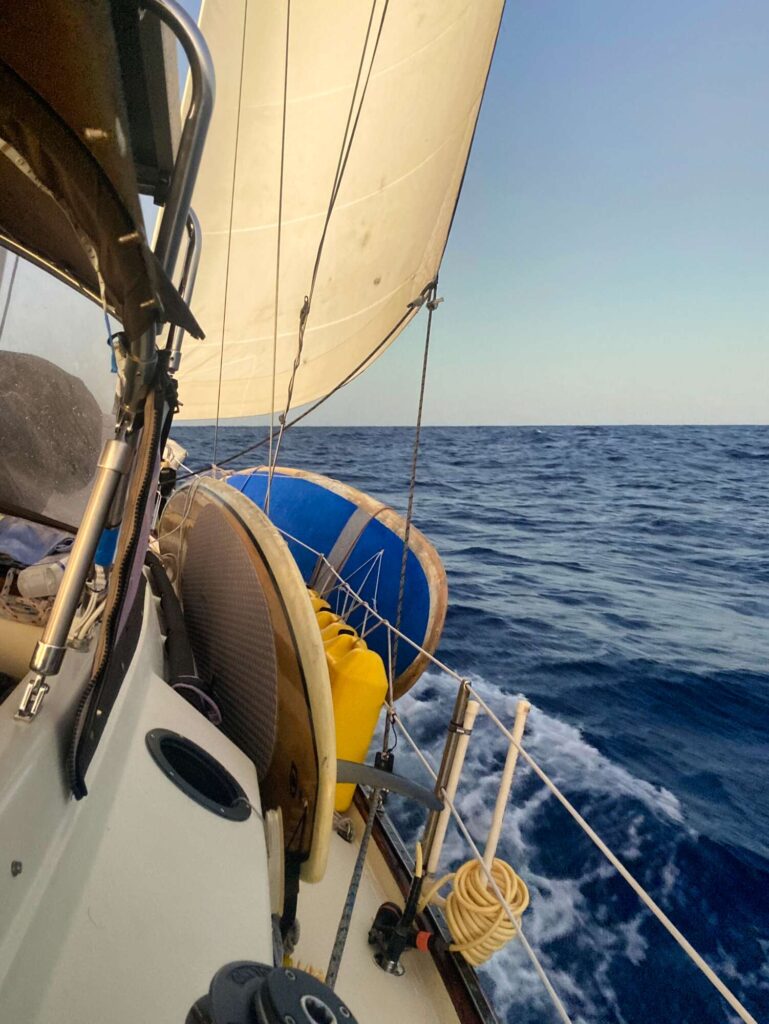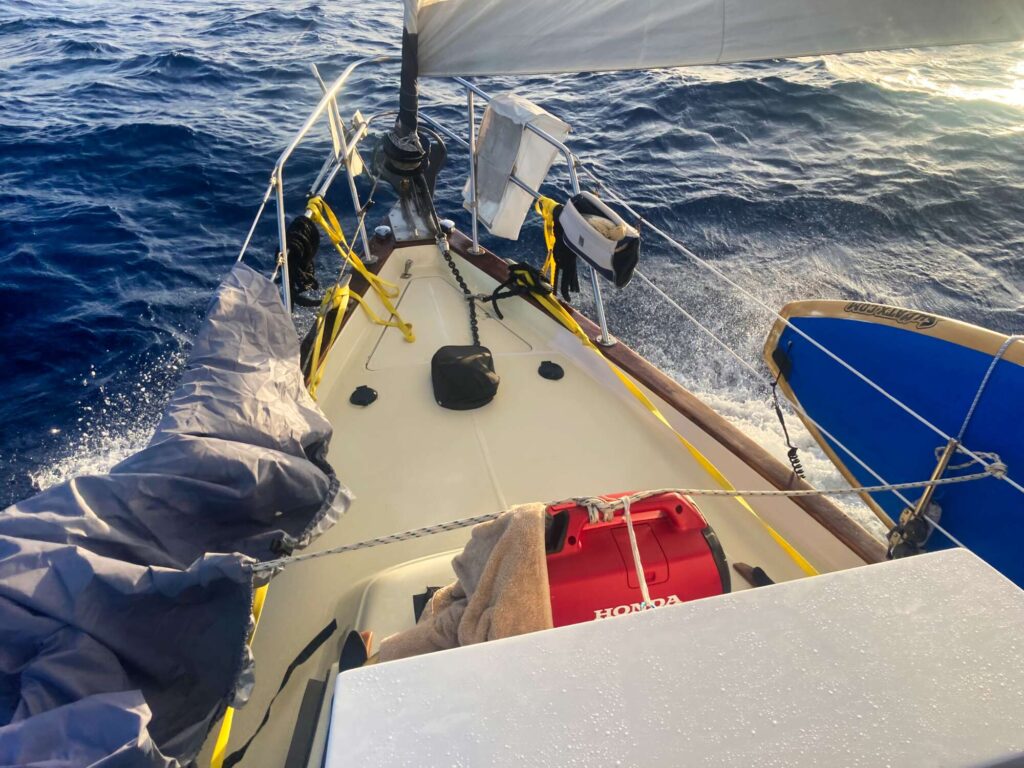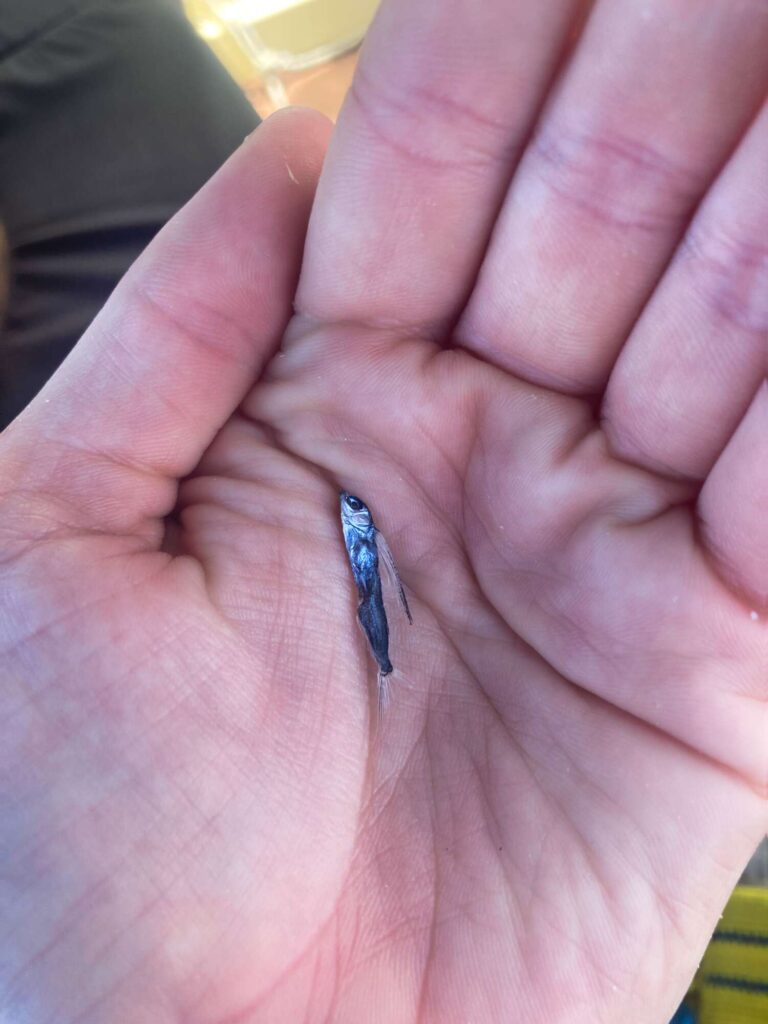Now having been three weeks at sea, and after running out of fuel in the main tank, followed by 16 hours of bobbing around in the doldrums, we finally got the wind we were praying for. On Day 22 we found ourselves with a sustained 20 knots of wind and a building swell on the beam. I told myself I could not be anxious about the uncomfortable conditions because we needed this to get us to our destination and complete the crossing as quickly as possible. I did my best to manage my feelings as we rolled back and forth with the occasional wave braking on the side of the boat, drenching me in the cockpit.
During my watch, the wind clocked around to the south forcing us to sheet the sails in tight and start beating upwind, close hauled on a port tack. Not long after this I started to become concerned with the security of the paddled boards. When heeling over and bashing into the oncoming waves the paddle boards, which sit on a rack attached to the starboard stanchions, were getting submerged and could eventually be torn loose. I asked Eitan to help me move them forward but every good roll would send them backwards again. Eitan was worried that a strong enough roll could potentially put enough force on the paddle board rack to rip the stanchions out of the deck. Normally you would strap the boards down on deck under these conditions, but bringing the paddle boards on deck made the front of the boat inaccessible which would be problematic for other reasons. We tried a few different methods of securing the boards while getting completely soaked by the water splashing up on deck. Eitan became so frustrated that he contemplated releasing them overboard instead of risking damage to SV Sierra Wind. Finally, we decided to bring just one board on deck and tied the other in a way that took most of the stress off the rack.
The windy conditions persisted and the day was spent getting saltier and saltier as we continued to bash upwind through the white capping swells and sea spray. We put up the eisenglass covers to prevent waves from coming into the cockpit, but unfortunately things were getting a bit damp down below. Any window or hatch on a boat has some leaking potential but our V-birth hatch is particularly susceptible to water intrusion if waves are breaking over the bow. Our poor crew had to lay down towels and bins to manage the leaking and try to get their rest in the wet cabin at the same time. On the bright side, we were finally making some really good SOG (Speed Over Ground) as measured by the GPS and had our fasted day and best 24-hour progress yet.
In the evening, Simone made a comment about the water tasting a bit funny and we thought she was just uncomfortable with the relentless conditions and complaining. However, I also had come down with a horrible headache, so we gave it more consideration. Eitan tested the salinity of our drinking water and found that it was no longer drinkable and had become brackish. Suddenly, my raging headache started to make sense and despite drinking water all day, I was actually becoming more and more dehydrated. After making an entire tank of fresh water the day before, while conditions were still calm, we had managed to contaminate the entire tank. With the water undrinkable, we drained the water tank by taking brackish showers and enjoyed our only indoor showers of the entire passage.
We were perplexed as to how this contamination could occur, and to make matters worse our salinity meter was low batteries so we had to figure out the issue fast. Eitan began looking at the different valves and switches of the water maker system but it seemed so strange to me that he successfully made water with no issues for the last 6 months with this same setup. How could saltwater have gotten into the fresh water tank? Then I thought back to the earlier paddle board situation and remembered the vent for the water tank sits just below the paddle boards and had been submerged throughout the day. I messaged my dad on the satellite phone and asked him to do a quick calculation of how much seawater intrusion it would take to contaminate 100 gallons of fresh water. It turned out that we only needed about a gallon of seawater to pulse back into the tank through the vent to do this, which seemed quite possible given the conditions.
We drained the tank down and Eitan started the water maker to refill the tank. But we had a new problem now. Since the built-in water tank is the original one installed in the boat nearly 40 years ago, there is quite a lot of mineral buildup that has accumulated. We had previously cleaned out the tank but there were some chunks of mineral deposits we couldn’t get out. Draining the tank all the way down sucks those pieces into the water lines where they get removed by an in-line filter. Eitan removed the buildup from the filter, but it seemed that the line itself was still plugged from some of the mineral debris. So, even though we had filled the tank with fresh water, we couldn’t get it back out of the tank! I brainstormed with Eitan about a possible solution and I rigged up a fitting to be able to blow air back up into the water line. Luckily, after a few attempts this worked and the line was cleared.
It was a rough couple of days between the high winds, blowing white capped swells, rolling conditions and water contamination issue but seeing the miles count down kept our spirits up. With only 300 miles left to go, we could start counting down the days and hours until our landfall!






